Understanding the Frequency Characteristics of Current Error and Phase Displacement of the Corrected Inductive Current Transformer
Abstract
:1. Introduction
- development of the measuring circuit used to determine the magnetic part of the equivalent circuit of the inductive CT,
- evaluation of the transverse branch parameters of the equivalent circuit in a range of frequencies, from 50 Hz to 5 kHz,
- analysis of the values of the active and reactive component of the excitation current in the considered frequencies range,
- correlation of the frequency characteristics of the magnetic part of the equivalent circuit parameters with the obtained frequency characteristics of the current error and phase displacement,
- analysis of the influence of the self-generation phenomenon on the determined values of the transverse branch parameters of the equivalent circuit,
- construction of the vectorial diagram with considered influence of the applied turns number correction of the secondary winding,
- analysis of the change of the inductive CT vectorial diagrams with the increasing frequency of transformed distorted higher harmonics.
2. The Equivalent Circuit of the Inductive CT
- hk—index indicating the harmonic of hk order,
- i″μ—instantaneous value of the reactive component of the distorted excitation current,
- i″0—instantaneous value of the distorted excitation current,
- i″1—instantaneous value of the distorted primary current,
- i2—instantaneous value of the distorted secondary current,
- i″Fe—instantaneous value of the active component of the distorted excitation current,
- L″μhk—mutual inductance of the primary and the secondary windings for the hk harmonic,
- LL—load inductance of the secondary winding,
- Lr2—leakage inductance of the secondary winding,
- P1/P2—terminals of the primary winding,
- R2—resistance of the secondary winding,
- R″Fehk—resistance representing active power loss in the magnetic core for the hk harmonic,
- RL—load resistance of the secondary winding,
- S1/S2—terminals of the secondary winding,
- u″μ—instantaneous value of the magnetizing voltage,
- u2—instantaneous value of the distorted secondary voltage.
3. The Measuring Setup and Tested CT
- DPM—digital power meter,
- CS1/CS2—DPM channels designed for connection of current/voltage probe,
- V1/V2—DPM voltage channels,
- PPS—programable power source,
- i1A—the instantaneous value of the current of the additional primary winding of inductive CT under conditions of rated ampere turns,
- iD—the instantaneous value of the differential current,
- i2—the instantaneous value of the secondary current,
- P1/P2—terminals of the primary winding,
- P1A/P2A—terminals of the additional primary winding,
- RL—resistance of the load of the secondary winding under normal operating conditions,
- RD—the non-inductive current shunt characterized by resistance equal to 10 Ω used to measure the differential current,
- RS—the non-inductive current shunt characterized by resistance equal to 0.1 Ω used to measure the current in the additional primary winding,
- S1/S2—terminals of the secondary winding,
- S1A/S2A—terminals of the additional secondary winding,
- IT—insulating transformer.
- UDhk—the rms value of the hk harmonic of voltage on RD current shunts associated with the differential current,
- UShk—the rms value of the hk harmonic of voltage on the RS current shunt associated with the current in additional primary winding.
- φhk—phase angle between the hk harmonic of two measured voltages of current shunts.
- current error: (0.1 ± 0.003)% for 50 Hz and (0.1 ± 0.017)% for 5 kHz,
- phase displacement: (0.1 ± 0.002)° for 50 Hz and (0.1 ± 0.01)° for 5 kHz.
- I%µhk—vector of the hk harmonic reactive component of the distorted excitation current expressed as a percentage of the primary current converted to the secondary side,
- I%Fehk—vector of the hk harmonic active component of the distorted excitation current expressed as a percentage of the primary current converted to the secondary side,
- I″1hk—vector of the hk harmonic of the distorted primary current,
- I2hk—vector of the hk harmonic of the distorted secondary current,
- Uµhk—vector of the hk harmonic of the distorted magnetizing voltage,
- αhk—value of the phase angle between hk harmonics of the distorted magnetizing voltage Uµhk and the distorted primary current I″1hk,
- βhk—value of the phase angle between hk harmonics of the distorted magnetizing voltage Uµhk and the composite error ε%Ihk,
- γhk—value of the phase angle between hk harmonics of the active component of the distorted excitation current I%Fehk and the composite error η%Ihk,
- ωhk—value of the phase angle between hk harmonics of the distorted secondary current I2hk and the composite error η%Ihk,
- ΔIhk—vector of the hk harmonic of the current error of the inductive CT,
- ΔIz—vector of the hk harmonic representing the change of current error of inductive CT caused by the turns ratio correction,
- δφhk—vector of the phase shift between hk harmonic of the secondary current and hk harmonic of the converted primary current of the CT,
- ε%Ihk—vector of the hk harmonic of the composite error of inductive CT after utilization of the turns ratio correction,
- η%Ihk—vector of the hk harmonic of the composite error of inductive CT before utilization of the turns ratio correction.
4. The Frequency Characteristics of the Values of Current Error and Phase Displacement
5. Analysis of the Values of the Equivalent Circuit Components Representing Magnetic Core Parameters Determined for Distorted Current Harmonics
6. The Vectorial Diagrams for Tested CT
7. Conclusions
Author Contributions
Funding
Institutional Review Board Statement
Informed Consent Statement
Data Availability Statement
Conflicts of Interest
References
- Yang, T.; Pen, H.; Wang, D.; Wang, Z. Harmonic analysis in integrated energy system based on compressed sensing. Appl. Energy 2016, 165, 583–591. [Google Scholar] [CrossRef]
- Haas, A.; Niitsoo, J.; Taklaja, P.; Palu, I. Analysis of electricity meters under distorted load conditions. In Proceedings of the PQ 2012: 8th International Conference-2012 Electric Power Quality and Supply Reliability, Conference Proceedings, Tartu, Estonia, 11–13 June 2012; pp. 281–284. [Google Scholar]
- Dirik, H.; Duran, I.U.; Gezegin, C. A Computation and Metering Method for Harmonic Emissions of Individual Consumers. IEEE Trans. Instrum. Meas. 2019, 68, 412–420. [Google Scholar] [CrossRef]
- Mingotti, A.; Peretto, L.; Bartolomei, L.; Cavaliere, D.; Tinarelli, R. Are inductive current transformers performance really affected by actual distorted network conditions? An experimental case study. Sensors 2020, 20, 927. [Google Scholar] [CrossRef] [PubMed] [Green Version]
- Locci, N.; Muscas, C. Comparative analysis between active and passive current transducers in sinusoidal and distorted conditions. IEEE Trans. Instrum. Meas. 2001, 50, 123–128. [Google Scholar] [CrossRef]
- Zobaa, A.F.; Abdel Aleem, S.H.E. A new approach for harmonic distortion minimization in power systems supplying nonlinear loads. IEEE Trans. Ind. Inform. 2014, 10, 1401–1412. [Google Scholar] [CrossRef] [Green Version]
- Mazin, H.E.; Xu, W.; Huang, B. Determining the harmonic impacts of multiple harmonic-producing loads. IEEE Trans. Power Deliv. 2011, 26, 1187–1195. [Google Scholar] [CrossRef]
- Sharma, H.; Rylander, M.; Dorr, D. Grid impacts due to increased penetration of newer harmonic sources. IEEE Trans. Ind. Appl. 2016, 52, 99–104. [Google Scholar] [CrossRef]
- IEC 61869-2. Instrument Transformers—Additional Requirements for Current Transformers; IEC: Geneva, Switzerland, 2012. [Google Scholar]
- Kaczmarek, M.; Stano, E. Nonlinearity of Magnetic Core in Evaluation of Current and Phase Errors of Transformation of Higher Harmonics of Distorted Current by Inductive Current Transformers. IEEE Access 2020, 8, 118885–118898. [Google Scholar] [CrossRef]
- Stano, E.; Kaczmarek, M. Wideband self-calibration method of inductive cts and verification of determined values of current and phase errors at harmonics for transformation of distorted current. Sensors 2020, 20, 2167. [Google Scholar] [CrossRef] [Green Version]
- Kaczmarek, M. Inductive current transformer accuracy of transformation for the PQ measurements. Electr. Power Syst. Res. 2017, 150, 169–176. [Google Scholar] [CrossRef]
- Platero, C.A.; Sánchez-Fernández, J.Á.; Gyftakis, K.N.; Blázquez, F.; Granizo, R. Performance problems of non-toroidal shaped current transformers. Sensors 2020, 20, 3025. [Google Scholar] [CrossRef] [PubMed]
- Li, Z.; Chen, X.; Wu, L.; Ahmed, A.S.; Wang, T.; Zhang, Y.; Li, H.; Li, Z.; Xu, Y.; Tong, Y. Error analysis of air-core coil current transformer based on stacking model fusion. Energies 2021, 14, 1912. [Google Scholar] [CrossRef]
- Kaczmarek, M.; Stano, E. The Influence of the 3rd Harmonic of the Distorted Primary Current on the Self-Generation of the Inductive Current Transformers. IEEE Access 2022, 10, 55876–55887. [Google Scholar] [CrossRef]
- Brandolini, A.; Faifer, M.; Ottoboni, R. A simple method for the calibration of traditional and electronic measurement current and voltage transformers. IEEE Trans. Instrum. Meas. 2009, 58, 1345–1353. [Google Scholar] [CrossRef]
- Laurano, C.; Toscani, S.; Zanoni, M. A simple method for compensating harmonic distortion in current transformers: Experimental validation. Sensors 2021, 21, 2907. [Google Scholar] [CrossRef] [PubMed]
- Cristaldi, L.; Faifer, M.; Laurano, C.; Ottoboni, R.; Toscani, S.; Zanoni, M. A Low-Cost Generator for Testing and Calibrating Current Transformers. IEEE Trans. Instrum. Meas. 2019, 68, 2792–2799. [Google Scholar] [CrossRef]
- Kaczmarek, M.L.; Stano, E. Application of the inductive high current testing transformer for supplying of the measuring circuit with distorted current. IET Electr. Power Appl. 2019, 13, 1310–1317. [Google Scholar] [CrossRef]
- Kaczmarek, M.; Kaczmarek, P. Comparison of the wideband power sources used to supply step-up current transformers for generation of distorted currents. Energies 2020, 13, 1849. [Google Scholar] [CrossRef]
- Kondrath, N.; Kazimierczuk, M.K. Bandwidth of current transformers. IEEE Trans. Instrum. Meas. 2009, 58, 2008–2016. [Google Scholar] [CrossRef]
- Gustavsen, B. Wideband Transformer Modeling Including Core Nonlinear Effects. IEEE Trans. Power Deliv. 2016, 31, 219–227. [Google Scholar] [CrossRef] [Green Version]
- Ballal, M.S.; Wath, M.G.; Suryawanshi, H.M. A novel approach for the error correction of ct in the presence of harmonic distortion. IEEE Trans. Instrum. Meas. 2019, 68, 4015–4027. [Google Scholar] [CrossRef]
- Haghjoo, F.; Pak, M.H. Compensation of CT distorted secondary current waveform in online conditions. IEEE Trans. Power Deliv. 2016, 31, 711–720. [Google Scholar] [CrossRef]
- Collin, A.J.; Femine, A.D.; Gallo, D.; Langella, R.; Luiso, M. Compensation of current transformers’ nonlinearities by tensor linearization. IEEE Trans. Instrum. Meas. 2019, 68, 3841–3849. [Google Scholar] [CrossRef]
- Gallo, D.; Landi, C.; Luiso, M. Real-time digital compensation of current transformers over a wide frequency range. IEEE Trans. Instrum. Meas. 2010, 59, 1119–1126. [Google Scholar] [CrossRef]
- Kaczmarek, M. The source of the inductive current transformers metrological properties deterioration for transformation of distorted currents. Electr. Power Syst. Res. 2014, 107, 45–50. [Google Scholar] [CrossRef]
- Kaczmarek, M. Estimation of the inductive current transformer derating for operation with distorted currents. Bull. Polish Acad. Sci. Tech. Sci. 2014, 62, 363–366. [Google Scholar] [CrossRef] [Green Version]
- Cataliotti, A.; Di Cara, D.; Emanuel, A.E.; Nuccio, S. Current transformers effects on the measurement of harmonic active power in LV and MV networks. IEEE Trans. Power Deliv. 2011, 26, 360–368. [Google Scholar] [CrossRef]
- Kaczmarek, M. Wide frequency operation of the inductive current transformer with Ni80Fe20 toroidal core. Electr. Power Compon. Syst. 2014, 42, 1087–1094. [Google Scholar] [CrossRef]
- Kaczmarek, M.; Szczęsny, A.; Stano, E. Operation of the Electronic Current Transformer for Transformation of Distorted Current Higher Harmonics. Energies 2022, 15, 4368. [Google Scholar] [CrossRef]
- Joint Committee For Guides In Metrology. Evaluation of Measurement Data–Guide to the Expression of Uncertainty in Measurement; ISO: Geneva, Switzerland, 2008; Volume 50, p. 134. [Google Scholar]
- Stano, E. The Method to Determine the Turns Ratio Correction of the Inductive Current Transformer. Energies 2021, 14, 8602. [Google Scholar] [CrossRef]
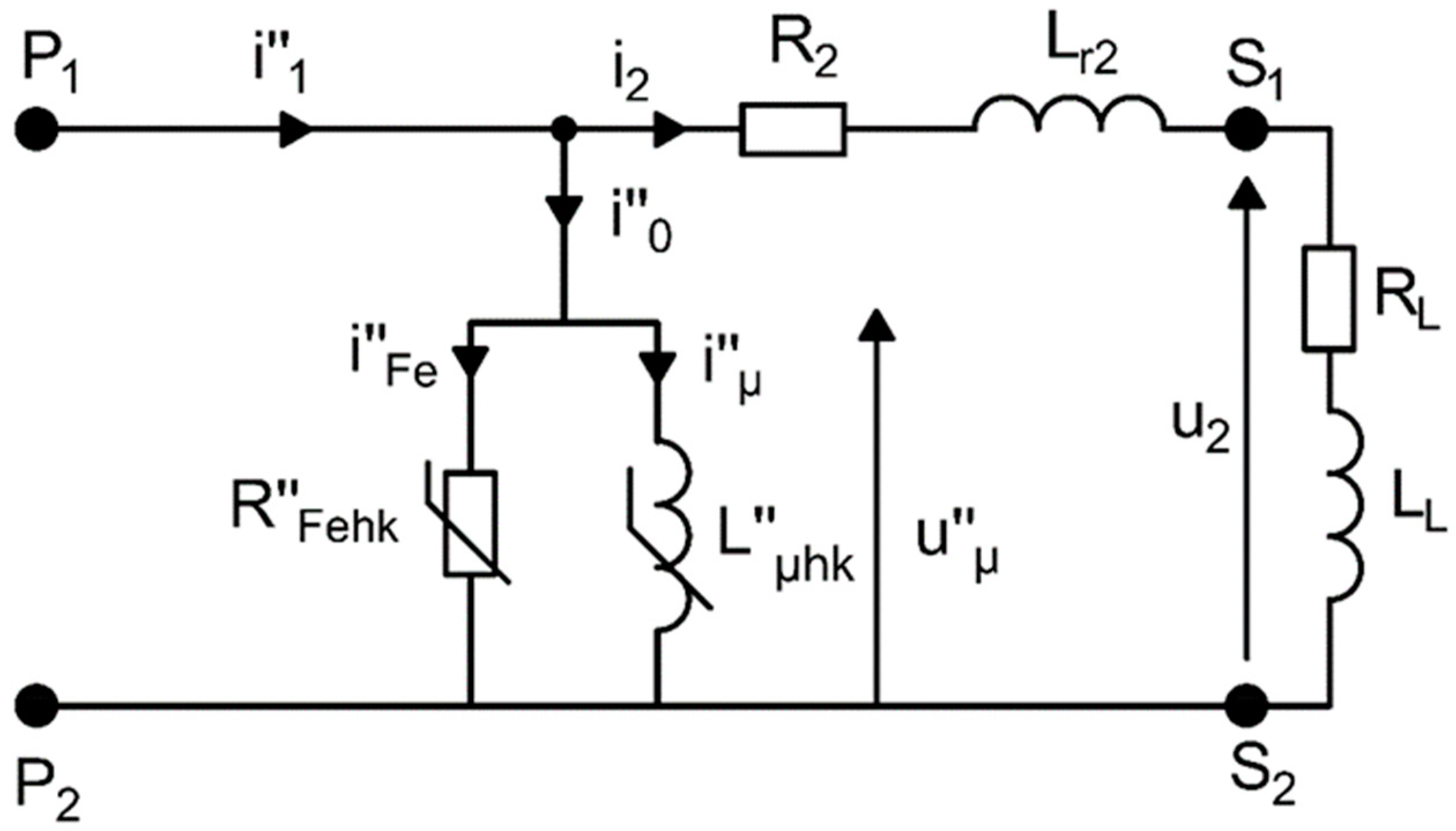
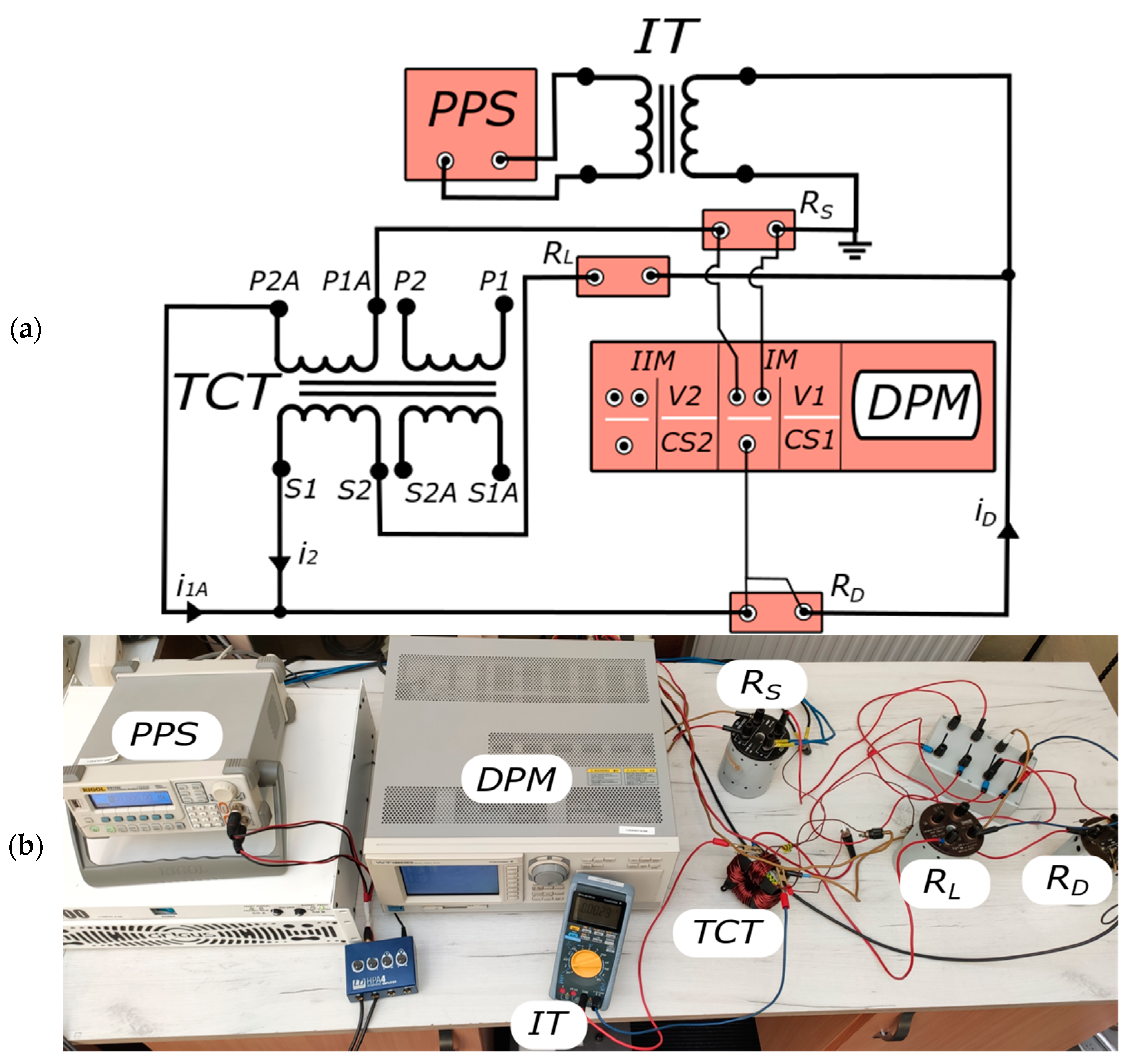
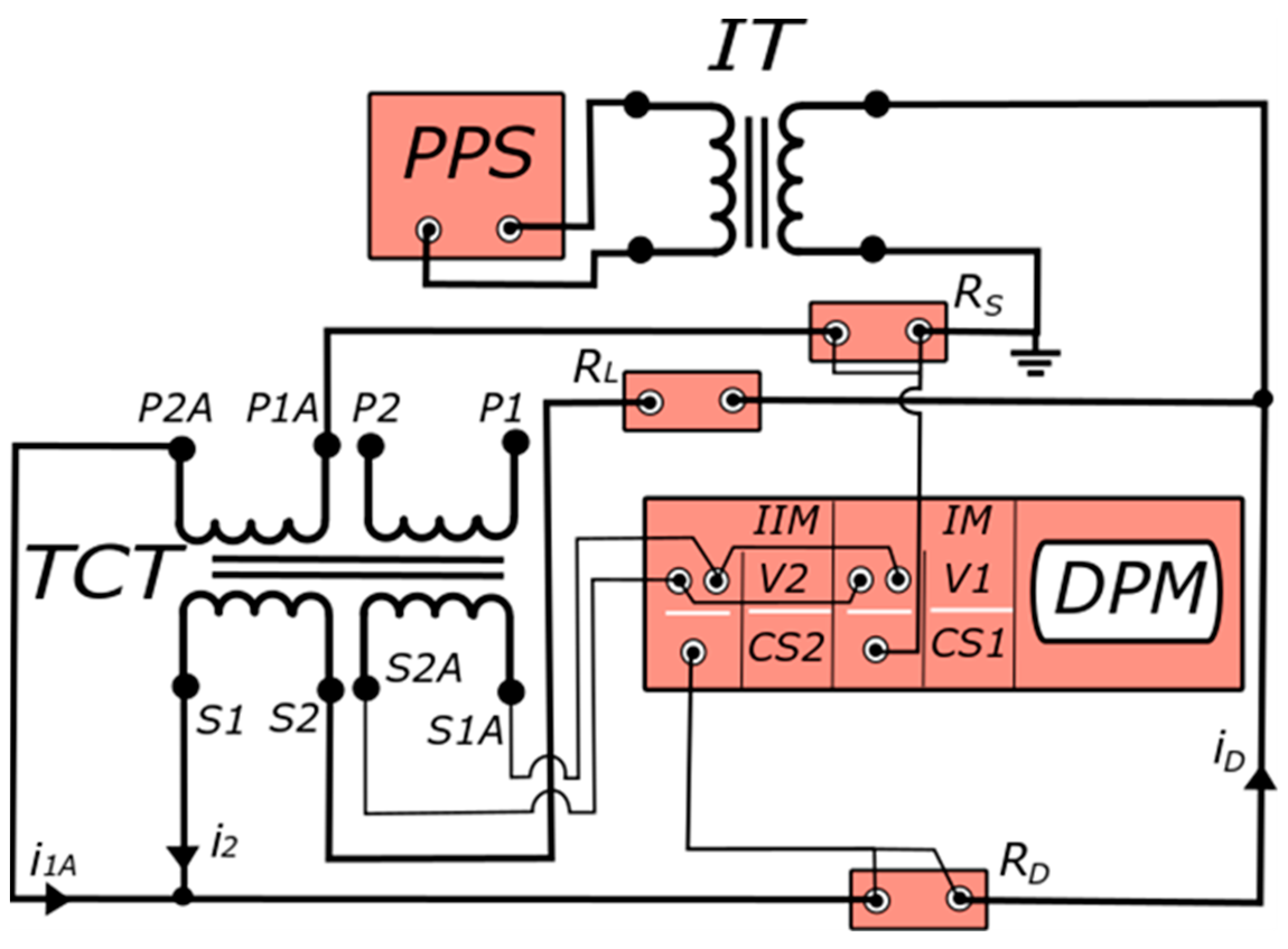
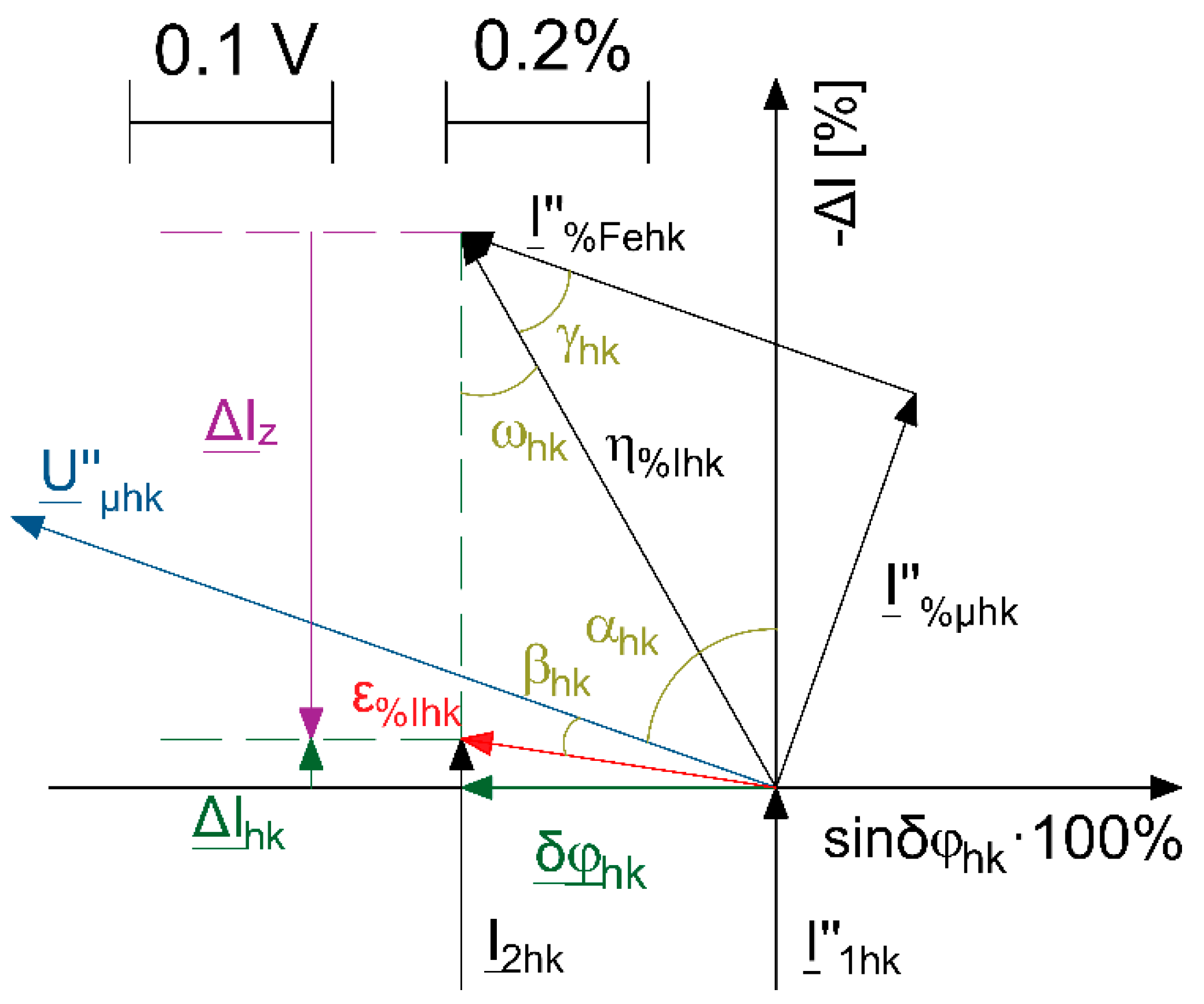
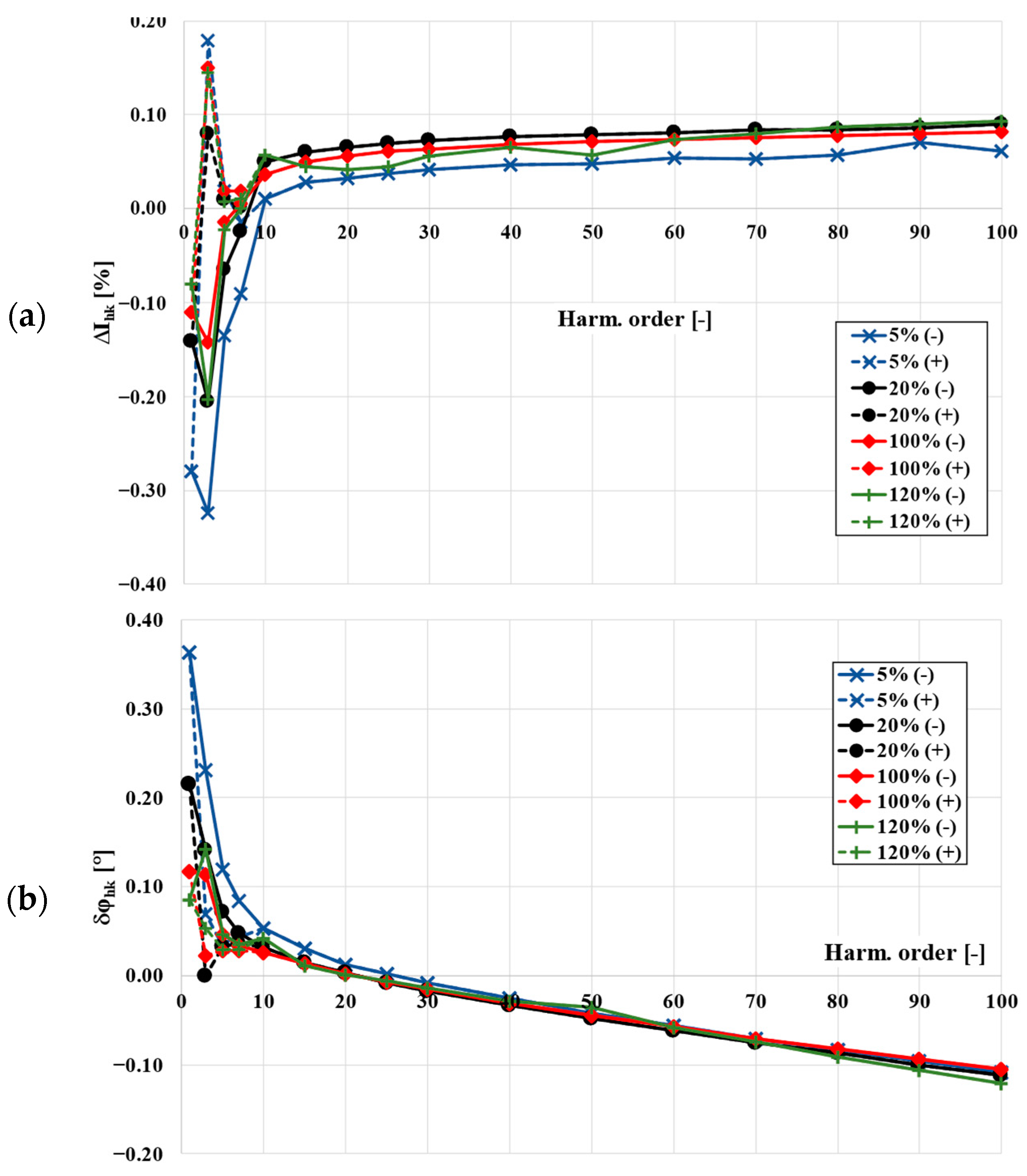
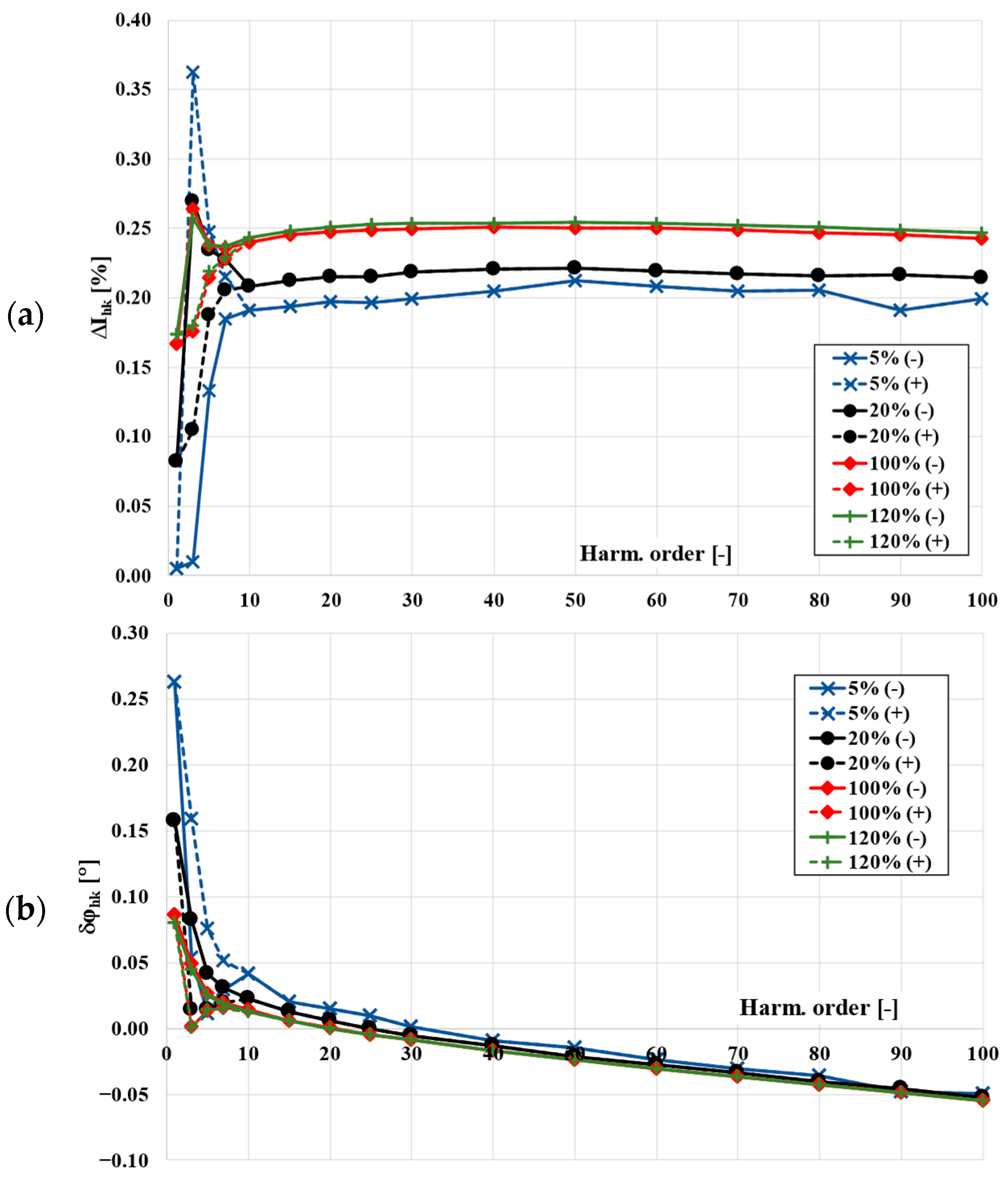
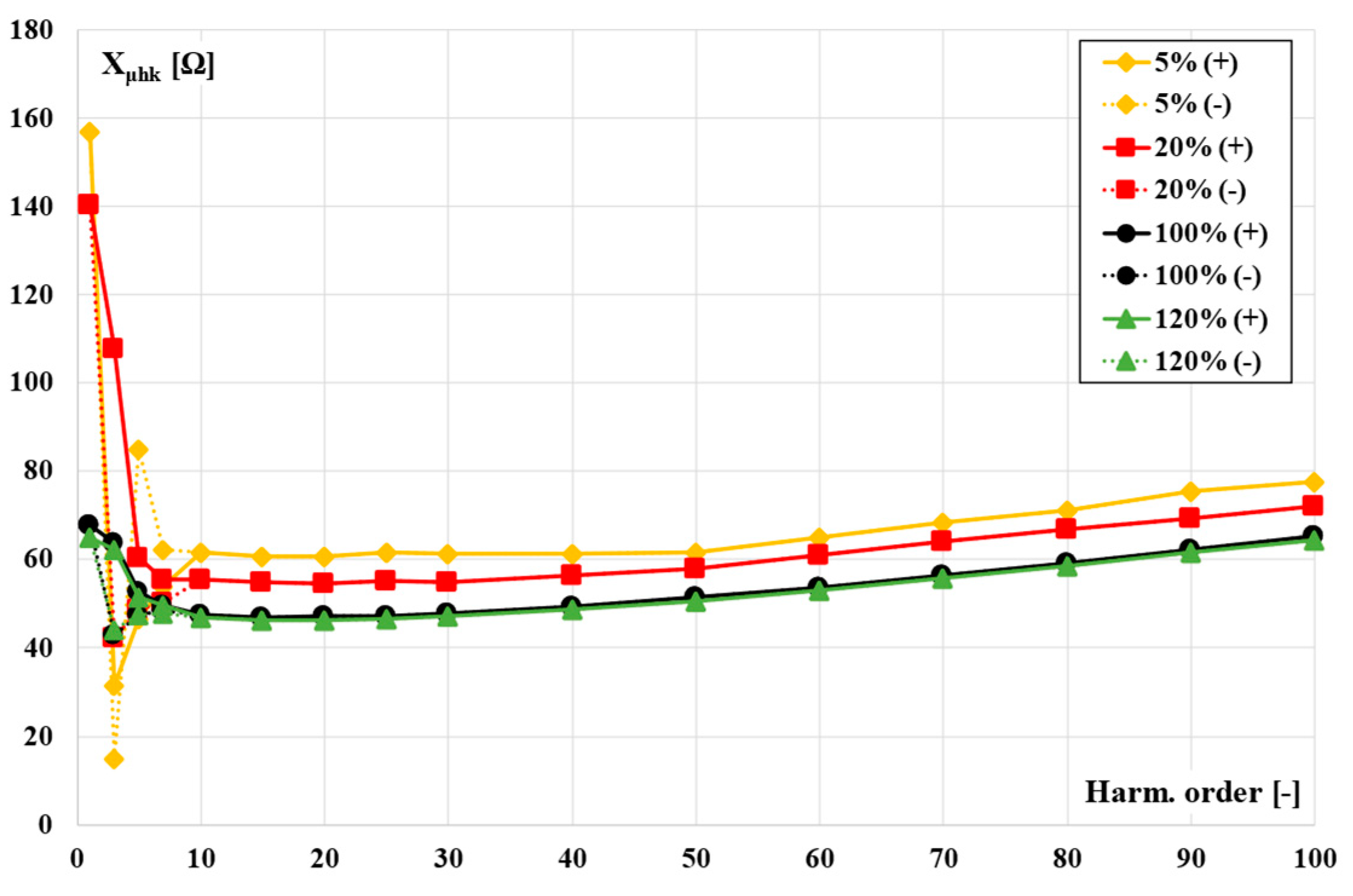
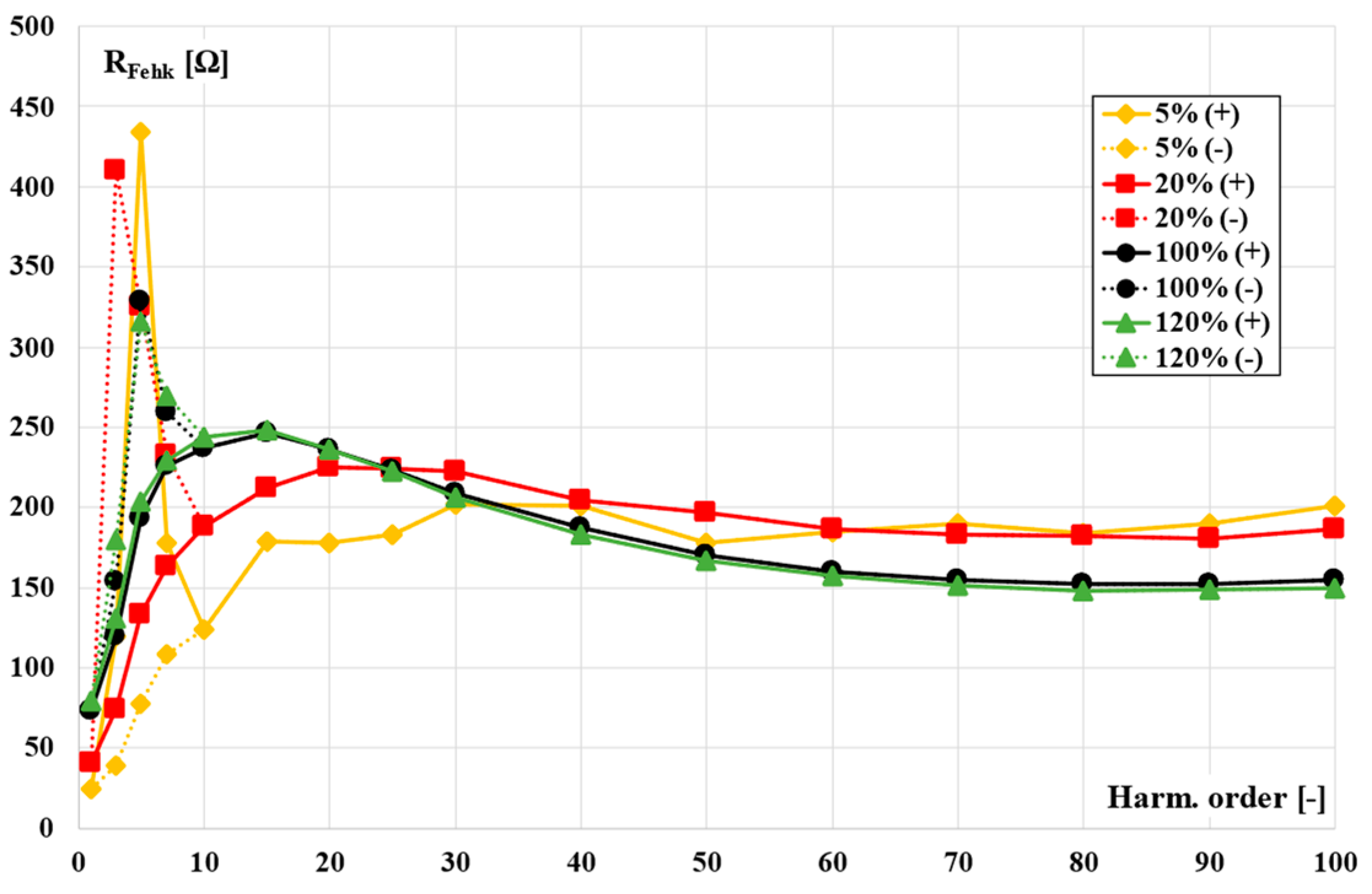
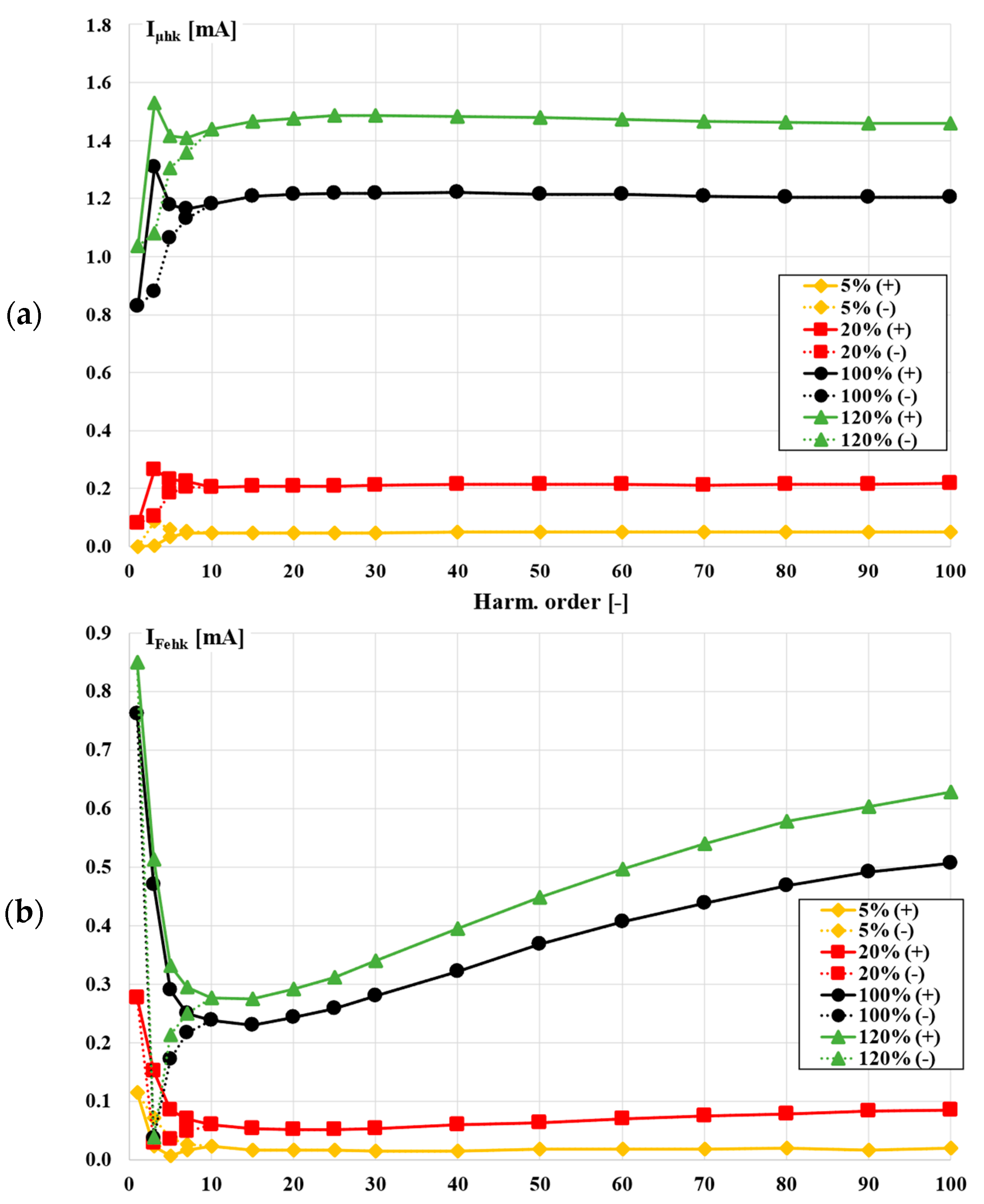
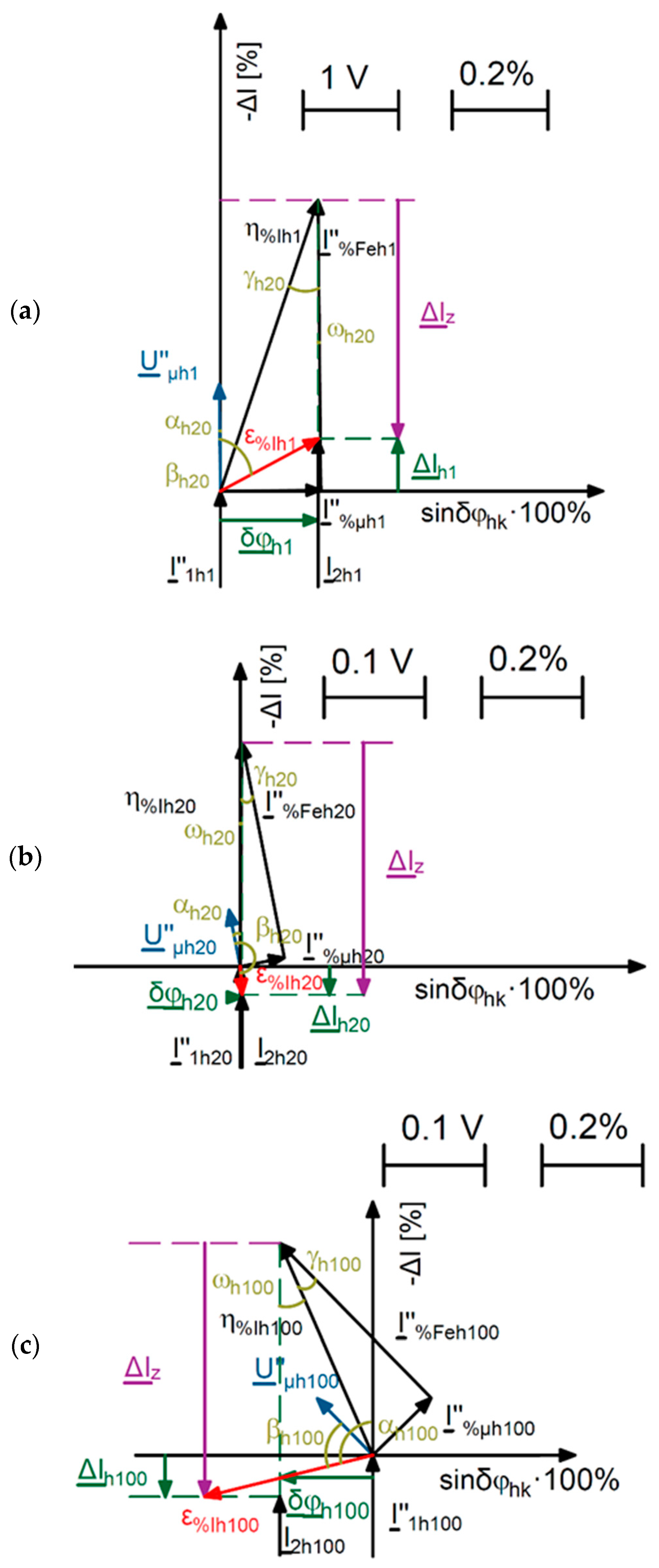
Publisher’s Note: MDPI stays neutral with regard to jurisdictional claims in published maps and institutional affiliations. |
© 2022 by the authors. Licensee MDPI, Basel, Switzerland. This article is an open access article distributed under the terms and conditions of the Creative Commons Attribution (CC BY) license (https://creativecommons.org/licenses/by/4.0/).
Share and Cite
Stano, E.; Kaczmarek, P.; Kaczmarek, M. Understanding the Frequency Characteristics of Current Error and Phase Displacement of the Corrected Inductive Current Transformer. Energies 2022, 15, 5436. https://doi.org/10.3390/en15155436
Stano E, Kaczmarek P, Kaczmarek M. Understanding the Frequency Characteristics of Current Error and Phase Displacement of the Corrected Inductive Current Transformer. Energies. 2022; 15(15):5436. https://doi.org/10.3390/en15155436
Chicago/Turabian StyleStano, Ernest, Piotr Kaczmarek, and Michal Kaczmarek. 2022. "Understanding the Frequency Characteristics of Current Error and Phase Displacement of the Corrected Inductive Current Transformer" Energies 15, no. 15: 5436. https://doi.org/10.3390/en15155436
APA StyleStano, E., Kaczmarek, P., & Kaczmarek, M. (2022). Understanding the Frequency Characteristics of Current Error and Phase Displacement of the Corrected Inductive Current Transformer. Energies, 15(15), 5436. https://doi.org/10.3390/en15155436






